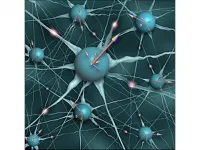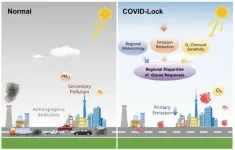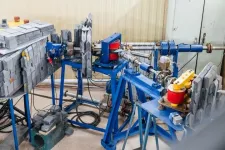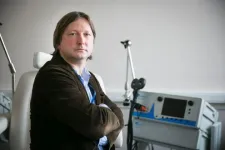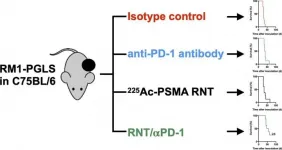(Press-News.org) Cells, like humans, cast votes to make decisions as a group. But how do they know what to vote for? Researchers at the Francis Crick Institute and King's College London have uncovered how cells actively seek information in order to make faster and better collective decisions to coordinate the growth of new blood vessels. This provides a new basis for understanding intelligence in cells.
The process of how cells precisely and quickly coordinate action when they create new tissue is complex. They must collectively decide which cells should take on specific jobs and ensure that not too many or too few cells are fulfilling each role.
In their study, published in Philosophical Transactions of the Royal Society B, the researchers found that when growing new blood vessels, cells make collective decisions using a process of active perception. This is where moving around to better sense the environment helps inform a decision.
The researchers compare this to entering a dark, unfamiliar room and extending your arms to feel around the wall for a light switch. In the case of the cells, they reach out long 'fingers' and feel their way in the environment. This allows them to quickly choose the cell that senses the most signal from the surroundings to become their leader. This leader, called a tip cell, drives the new blood vessel forward.
Katie Bentley, senior author and group leader of the Cellular Adaptive Behaviour Laboratory at the Crick and senior lecturer at King's College London says: "In most biology textbooks, processes are set out step by step in a certain order. Molecule A binds to receptor B and causes movement C. In the case of this important collective cell decision, steps happen alongside each other rather than consecutively, as cells simultaneously move about while 'deciding' how to form new tissue.
"This ability to use feedback from moving through the world while making a choice is something we usually associate with 'higher-organisms' so recognising how these processes also play a role in more basic living systems could reveal fundamental aspects of biological function driving them to behave as they do.
"And in cases where this process has gone wrong, it could even unlock new therapies and treatments that impact these feedback processes."
In their proof of concept work, the researchers focussed on blood vessel formation, which is vital to healthy tissue development and repair, and is often dysregulated in disease.
At the start of this process, some endothelial cells along the outside of an existing blood vessel turn into tip cells. These tip cells have long finger-like protrusions on their surface, called filopodia, and are the first to move out from the existing vessel to form the head of the new, sprouting vessel.
Many aspects of the timing and cell interactions involved in this process, including how the endothelial cells decide which of them should become tip cells, are not yet understood.
Using computer simulations and studies of zebrafish embryos, the researchers found that the filopodia start forming on the cell surface before it has committed to becoming a tip cell. The filopodia then extend out into the surrounding tissue and detect signals which can either trigger the cell to become a tip cell or inhibit it. This process of filopodia movement and sensing constitutes an active perception feedback loop.
Importantly, to stop all the cells becoming tip cells, neighbouring cells send signals to each other so that only every other cell specialises.
Bahti Zakirov, author and researcher at the Crick and King's College London says: "It was exciting to find that the creation of filopodia was taking place before the cells had fully become tip cells. Until now these protrusions have been considered as merely the end product of the cell decision making process. We've flipped this on its head and shown that the cells use filopodia to better sense their environment and inform their decision - highlighting the feedback between movement and sensing as an important player in the decision-making process."
When the researchers disrupted the filopodia in their computer models and in zebrafish embryos, fewer tip cells were selected and this selection happened more slowly. This delayed process has previously been shown to lead to the formation of less dense blood vessel networks.
Zakirov continues: "If tip cell selection goes wrong or is slowed down this can lead to poorly branched or abnormal vessel networks, limiting blood flow. This in turn, can contribute to diseases such as cancer, retinopathy and HHT- hereditary haemorrhagic telangiectasia. A greater understanding of how to speed up or alter the branching tempo could therefore lead to new therapies which can regulate blood vessel density. This could also help in the creation of artificial organs or tissues as these also need dense blood vessel networks."
Bentley adds: "This work has not only given us a a fresh perspective on the tip cell selection process, revealing a hidden, yet vital time-keeping role for filopodia, but also opened the door to a myriad of new and exciting research directions. We will be exploring some of these important questions in future work, with a view to better interpreting and understanding cell behaviour."
INFORMATION:
For further information, contact: press@crick.ac.uk or +44 (0)20 3796 5252
Notes to Editors
Bahti, Z. et al. (2020). Active Perception during Angiogenesis: Filopodia speed up Notch selection of tip cells in silico and in vivo. Philosophical Transactions of the Royal Society B. https://doi.org/10.1098/rstb.2019.0753
The Francis Crick Institute is a biomedical discovery institute dedicated to understanding the fundamental biology underlying health and disease. Its work is helping to understand why disease develops and to translate discoveries into new ways to prevent, diagnose and treat illnesses such as cancer, heart disease, stroke, infections, and neurodegenerative diseases.
An independent organisation, its founding partners are the Medical Research Council (MRC), Cancer Research UK, Wellcome, UCL (University College London), Imperial College London and King's College London.
The Crick was formed in 2015, and in 2016 it moved into a brand new state-of-the-art building in central London which brings together 1500 scientists and support staff working collaboratively across disciplines, making it the biggest biomedical research facility under a single roof in Europe.
http://crick.ac.uk/
Is a quantum machine really more efficient than a conventional machine for performing calculations? Demonstrating this 'advantage' experimentally is particularly complex and a major research challenge around the world1. Scientists from the CNRS2, the University of Edinburgh (Scotland) and the QC Ware, Corp., (France and USA) have just proved that a quantum machine can perform a given verification task in seconds when the same exercise would take a time equivalent to the age of the universe for a conventional computer. For this demonstration, they combined a complex interactive algorithm that solves a certain type of mathematical problem with limited information and a simple experimental photonics ...
Goal 7 of the Sustainable Development Goals (SDGs) aims to ensure access to affordable, reliable, sustainable and modern energy for all by 2030. Yet according to new research by Copenhagen Business School the poor planning and execution of decarbonisation strategies in emerging markets challenges the aims of Goal 7.
"In the effort to produce renewable energy and decarbonise their economies, emerging countries have neglected the effect on marginalised populations, which could ultimately prove unsustainable for all," says Assistant Professor Jacobo Ramirez from the ...
An important class of challenging computational problems, with applications in graph theory, neural networks, artificial intelligence and error-correcting codes can be solved by multiplying light signals, according to researchers from the University of Cambridge and Skolkovo Institute of Science and Technology in Russia.
In a paper published in the journal Physical Review Letters, they propose a new type of computation that could revolutionise analogue computing by dramatically reducing the number of light signals needed while simplifying the search for the best mathematical solutions, allowing for ultra-fast optical computers.
Optical or ...
A way of using machine learning to more accurately identify patients with a mix of psychotic and depressive symptoms has been developed by researchers at the University of Birmingham.
Patients with depression or psychosis rarely experience symptoms of purely one or the other illness. Historically, this has meant that mental health clinicians give a diagnosis of a 'primary' illness, but with secondary symptoms. Making an accurate diagnosis is a big challenge for clinicians and diagnoses often do not accurately reflect the complexity of individual experience or indeed neurobiology.
Clinicians diagnosing psychosis, for example, would frequently regard depression as a secondary illness, with implications for treatment decisions which focus more on ...
The outbreak of COVID-19 raised a question about the relationship between anthropogenic emissions and air pollution, which has aroused heated discussion. Research on air-quality changes caused by the lockdowns in different areas shows similar substantial reductions in primary emissions. However, regional disparities exist in responses of secondary pollutants to emissions reduction, especially fine particulate matter and ozone (O3).
Professor Ding Aijun and his team from Nanjing University explored global air-quality changes during COVID-19 lockdowns and regional disparities in O3 responses to emission reductions. They integrated multiple observational datasets, including global air quality ...
In a new study published in Journal of Extracellular Vesicles, Chen-Yu Zhang's group and Antonio Vidal-Puig's group at University of Cambridge report that pancreatic β cells secrete miR-29 family members (miR-29a, miR-29b and miR-29c) in response to high levels of free fatty acids (FFAs). These β cell-derived miR-29s are delivered to the liver, promoting insulin resistance and enhancing hepatic glucose output.
Over 100 years after insulin was discovered, it was believed that pancreatic β cells only secreted a single hormone--insulin. Pancreatic β cell-derived insulin regulates glucose homeostasis by binding with the insulin receptors located in the liver, skeletal ...
The scientists of Tomsk Polytechnic University jointly with the colleagues from Keysight company have conducted an experiment with an electron beam at the TPU microtron to study a super-radiant regime that occurs when radiation is generated by a train of electron bunches. The research findings obtained by a high-precision measurement of a spectral line width proved that about 8,000 electron bunches in a super-radiant regime form monochromatic Cherenkov radiation. This experiment was conducted for the first time. The fundamental research findings are published in the Scientific Reports academic journal (IF: 4.120, Q1) and can be used for further research on the new sources of radiation in the terahertz range.
A super-radiant regime is a coherent ...
Scientists at HSE University have learned that disagreeing with the opinion of other people leaves a 'trace' in brain activity, which allows the brain to later adjust its opinion in favour of the majority-held point of view. The article was published in Scientific Reports.
We often change our beliefs under the influence of others. This social behavior is called conformity and explains varios components of our behaviour, from voting at elections to fashion trends among teenagers.
Brain research has recently well informed about short-term effects of social influence on decision making. If our choice coincides with the point of view of the people who are important to us, this decision is reinforced in ...
Reston, VA--A combination of radionuclide therapy and immunotherapy has proven successful in slowing the progression of prostate cancer and increasing survival time, according to new research published in the February issue of The Journal of Nuclear Medicine. The results of the murine study indicate that radionuclide therapy promotes prostate cancer immunogenicity, provoking a cellular response that makes the tumors more receptive to immunotherapy.
"Prostate cancer is generally viewed as an immunological cold cancer in which immunotherapies only have moderate success," said Katharina Lückerath, PhD, assistant professor of preclinical ...
Geoscientists have released a video that for the first time shows the uninterrupted movement of the Earth's tectonic plates over the past billion years.
The international effort provides a scientific framework for understanding planetary habitability and for finding critical metal resources needed for a low-carbon future.
It reveals a planet in constant movement as land masses move around the Earth's surface, for instance showing that Antarctica was once at the equator.
The video is based on new research published in the March 2021 edition of ...
